The Intel Skylake-X Review: Core i9 7900X, i7 7820X and i7 7800X Tested
by Ian Cutress on June 19, 2017 9:01 AM ESTBenchmarking Performance: CPU Rendering Tests
Rendering tests are a long-time favorite of reviewers and benchmarkers, as the code used by rendering packages is usually highly optimized to squeeze every little bit of performance out. Sometimes rendering programs end up being heavily memory dependent as well - when you have that many threads flying about with a ton of data, having low latency memory can be key to everything. Here we take a few of the usual rendering packages under Windows 10, as well as a few new interesting benchmarks.
Corona 1.3
Corona is a standalone package designed to assist software like 3ds Max and Maya with photorealism via ray tracing. It's simple - shoot rays, get pixels. OK, it's more complicated than that, but the benchmark renders a fixed scene six times and offers results in terms of time and rays per second. The official benchmark tables list user submitted results in terms of time, however I feel rays per second is a better metric (in general, scores where higher is better seem to be easier to explain anyway). Corona likes to pile on the threads, so the results end up being very staggered based on thread count.
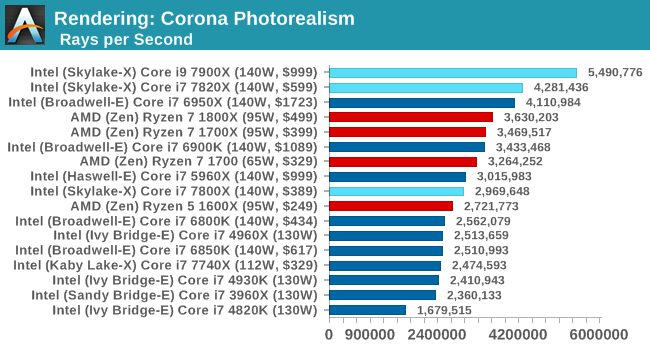
Blender 2.78
For a render that has been around for what seems like ages, Blender is still a highly popular tool. We managed to wrap up a standard workload into the February 5 nightly build of Blender and measure the time it takes to render the first frame of the scene. Being one of the bigger open source tools out there, it means both AMD and Intel work actively to help improve the codebase, for better or for worse on their own/each other's microarchitecture.
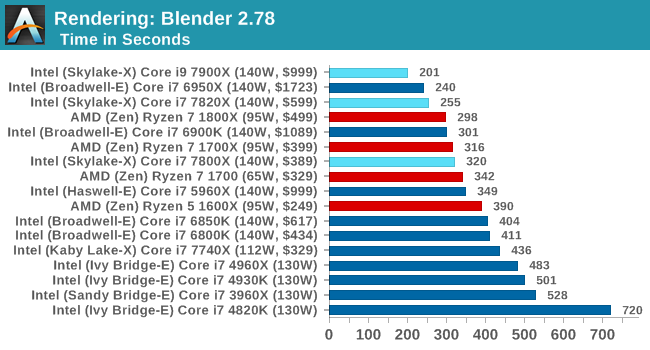
LuxMark
As a synthetic, LuxMark might come across as somewhat arbitrary as a renderer, given that it's mainly used to test GPUs, but it does offer both an OpenCL and a standard C++ mode. In this instance, aside from seeing the comparison in each coding mode for cores and IPC, we also get to see the difference in performance moving from a C++ based code-stack to an OpenCL one with a CPU as the main host.
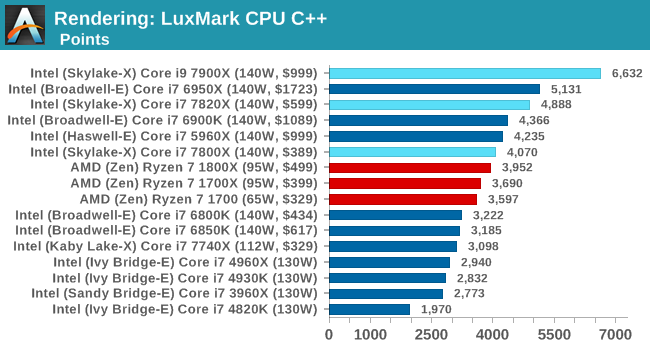
POV-Ray 3.7b3
Another regular benchmark in most suites, POV-Ray is another ray-tracer but has been around for many years. It just so happens that during the run up to AMD's Ryzen launch, the code base started to get active again with developers making changes to the code and pushing out updates. Our version and benchmarking started just before that was happening, but given time we will see where the POV-Ray code ends up and adjust in due course.
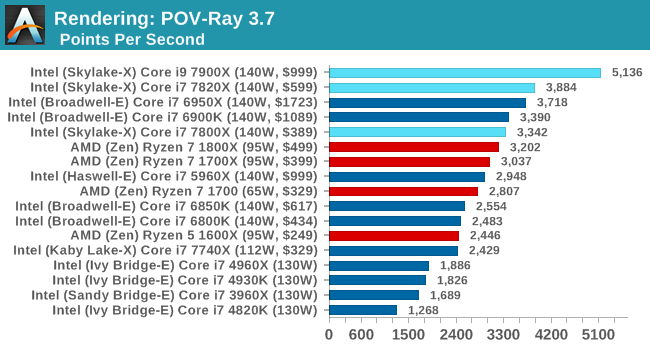
Cinebench R15
The latest version of CineBench has also become one of those 'used everywhere' benchmarks, particularly as an indicator of single thread performance. High IPC and high frequency gives performance in ST, whereas having good scaling and many cores is where the MT test wins out.
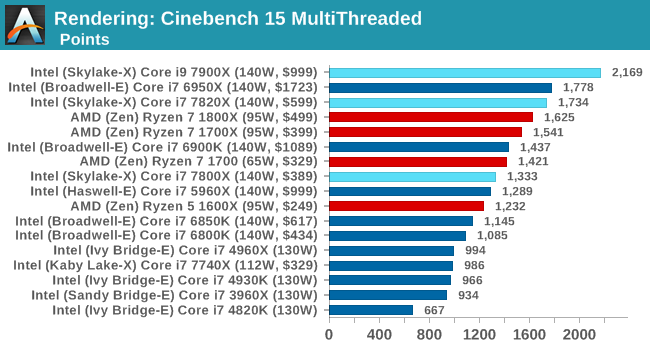
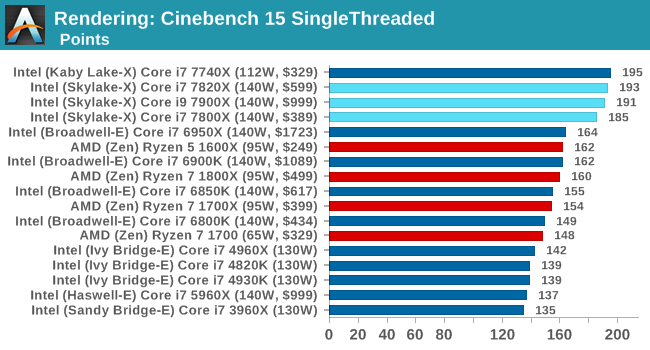










264 Comments
View All Comments
AnandTechReader2017 - Tuesday, June 20, 2017 - link
The Chill feature for AMD would probably be amazing for a mini-ITX build. Still waiting on AMD to launch dedicated graphics cards for laptops with it, would be amazing.I hope Nvidia comes up with a similar feature, would make gaming on laptops a lot nicer/quieter.
rocky12345 - Monday, June 19, 2017 - link
"As the first new serious entry into the HEDT space for AMD in almost five years, along with a new x86 core, AMD offered similar-ish performance to Broadwell-E in many aspects (within a few percent), but at half the price or better."Half right it was AMD's first serious entry into High end Mainstream Desktop in five years. We have not seem AMD's HEDT platform in action yet since it has not been released yet. With that said I was surprised how AMD's current Mainstream R7's were able to compete with Intels new HEDT platform so well. If this is what we are to expect from AMD's actual HEDT platform Intel will have a fight on their hands for sure.
I hope when AMD releases their Threadripper platform we get just as an extensive review for that as well. To me it is a lot more exciting to see x399 and threadripper in action than the x299 since Intel has been doing their HEDT platform for many years now and this will be the first time AMD has entered into the same Extreme high end space as Intel at the consumer level hardware.
Manch - Tuesday, June 20, 2017 - link
HEMD? LOLRyzen is a great chip no doubt. AMD is once again pushing Intel to iterate vs stagnate. AMD offers a great price/perf proc. But, AMD brought the comparison on themselves. Most previews were not against a 6700K or 7700K but against Intel's HEDT procs which AMD was clearly targeting with the pre-release benchmark comparos. It is not unfair to compare them.
Braincruser - Monday, June 19, 2017 - link
Any particular reason the mainstream intel processors are not in the benchmarks? One of the more important measurements for me is the difference between the mainstream and high end platforms.Ryan Smith - Monday, June 19, 2017 - link
While we technically have infinite space, we try not to overload the graphs with too many products, focusing on new products and certain generational comparisons. For specific comparisons you'd like to see that aren't in a graph, you can find all of that over in Bench.http://www.anandtech.com/bench/
AnandTechReader2017 - Tuesday, June 20, 2017 - link
Thanks for the link, I didn't know you guys had that.none12345 - Monday, June 19, 2017 - link
Small correction for your article, ryzen 7 has 20 pci lanes not 16. I am NOT counting 4 more for the chipset, if you count those its 24. Youve got 16 to the gpu, and 4 to a direct connected m.2(or 2 sata ports, but usually its a m.2)Tho thats not the whole story. Since technically you dont need the chipset, so you could connect something else instead on those 4 lanes. In the real world tho almost every motherboard will have a chipset there.
And then there are the usb ports which have direct connections on the chip as well. Thats could be counted as more pci lanes if one wanted to. They dont share the chipset link.
So depending on how you count it, its 20, 24, or 28 lanes. I would call it 20 and not count the usb or the chipset ones, but id definitly count the direct connected m.2
Nintendo Maniac 64 - Monday, June 19, 2017 - link
Uhhh, where's the results for Dolphin? It's on the "clock-for-clock" page but not on the "CPU system tests" page...Ro_Ja - Monday, June 19, 2017 - link
It's nice to see the Ryzen Chips keeping up with i9s.Hurr Durr - Tuesday, June 20, 2017 - link
Except they don`t, hence the price difference.